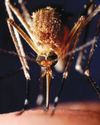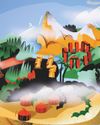Ever since a trip through a wormhole was first portrayed in 2001: A Space Odyssey 50 years ago, the idea of them has captured the public imagination. And small wonder: they’re the ultimate form of cosmic travel: a way of zipping across galaxies in an instant.

But while wormholes have become a staple of science fiction, among scientists they’ve been a source of endless frustration. Not because the idea is Eridiculous, but because it isn’t. The astonishing fact is that wormholes are a natural consequence of current theories of gravity, and were investigated by Einstein himself over 80 years ago. Ever since, researchers have been trying to find out if such a bizarre theoretical possibility could be a reality.
And now they have made a major breakthrough – one which exploits deep connections between the nature of space and time and the laws of the subatomic world. The result is a new understanding of exactly what’s required to make a real-life wormhole.
Einstein first investigated the properties of wormholes with his colleague Nathan Rosen in 1935, using his theory of gravity known as General Relativity. They found that what we now call a black hole could be connected to another via a tube-like ‘throat’. Now called the Einstein-Rosen bridge, this seemed to open the way to taking shortcuts through space and time, entering a black hole in one part of the Universe and emerging from another perhaps millions of light-years away, but without taking millions of years to do so – thus effectively travelling faster than the speed of light.
It was a stunning idea, but in the early 1960s it was dealt a severe blow by John Wheeler, the brilliant US physicist who first coined the terms ‘black hole’ and ‘wormhole’. Together with fellow theorist Robert Fuller, he showed that the Einstein
Rosen bridge would collapse almost as soon as it formed. As Dr Daniel Jafferis, associate professor of physics at Harvard University explains: “We could jump in from opposite sides and meet in the connected interior, but then we would both be doomed.”
This story is from the August 2018 edition of BBC Earth.
Start your 7-day Magzter GOLD free trial to access thousands of curated premium stories, and 9,000+ magazines and newspapers.
Already a subscriber ? Sign In
This story is from the August 2018 edition of BBC Earth.
Start your 7-day Magzter GOLD free trial to access thousands of curated premium stories, and 9,000+ magazines and newspapers.
Already a subscriber? Sign In

World's First Malaria Vaccine
The World Health Organization’s director-general hails ‘historic moment’ as mass immunisation of African children begins

Is River Pollution Putting The Species In Jeopardy Again?
Ten years ago, it was jubilantly announced that o ers had returned to every county in England. But is river pollution putting the species in jeopardy again?

The Big Burnout
Long hours, low pay and a lack of appreciation — among other things — can make for a stressful workplace and lead to burnout. It’s something we should all be concerned about, because over half of the workforce reports feeling it

Putting Nature To Rights
More countries are enshrining the right to a clean environment into law. So if a company or government is impinging upon that right, you could take them to court

Mega Spaceship: Is It Possible For China To Build A Kilometre-Long Spacecraft?
Buoyed on by its successful Moon missions, China has launched a five-year study to investigate the possibility of building the biggest-ever spacecraft

Are We Getting Happier?
Enjoying more good days than bad? Feel like that bounce in your step’s getting bigger? HELEN RUSSELL looks into whether we’re all feeling more cheery…

“Unless the Japanese got the US off their backs in the Pacific, they believed they would face complete destruction”
Eighty years ago Japan’s surprise raid on Pearl Harbor forced the US offthe fence and into the Second World War. Ellie Cawthorne is making a new HistoryExtra podcast series about the attack, and she spoke to Christopher Harding about the long roots of Japan’s disastrous decision

Your Mysterious Brain
Science has mapped the surface of Mars and translated the code for life. By comparison, we know next to nothing about what’s between our ears. Over the next few pages, we ask leading scientists to answer some of the most important questions about our brains…

Why Do We Fall In Love?
Is it companionship, procreation or something more? DR ANNA MACHIN reveals what makes us so willing to become targets for Cupid’s arrow

Detecting the dead
Following personal tragedy, the creator of that most rational of literary figures, Sherlock Holmes, developed an obsession with spiritualism. Fiona Snailham and Anna Maria Barry explore the supernatural interests of Sir Arthur Conan Doyle